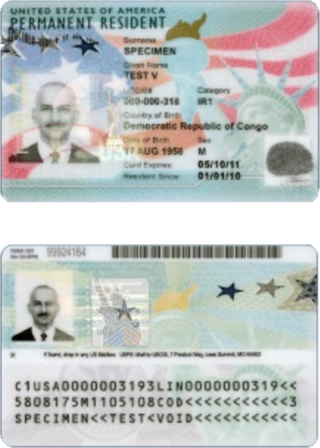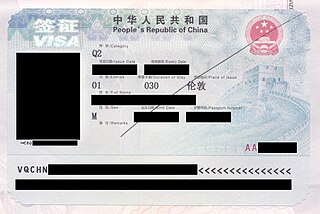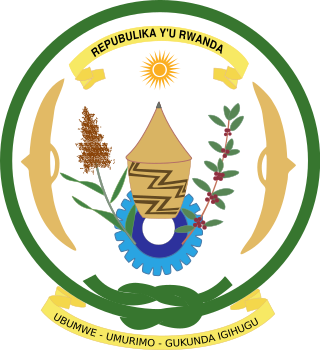Related Research Articles

A green card, known officially as a permanent resident card, is an identity document which shows that a person has permanent residency in the United States. Green card holders are formally known as lawful permanent residents (LPRs). As of 2019, there are an estimated 13.9 million green card holders, of whom 9.1 million are eligible to become United States citizens. Approximately 65,000 of them serve in the U.S. Armed Forces.

A visa is a conditional authorization granted by a polity to a foreigner that allows them to enter, remain within, or leave its territory. Visas typically include limits on the duration of the foreigner's stay, areas within the country they may enter, the dates they may enter, the number of permitted visits, or if the individual has the ability to work in the country in question. Visas are associated with the request for permission to enter a territory and thus are, in most countries, distinct from actual formal permission for an alien to enter and remain in the country. In each instance, a visa is subject to entry permission by an immigration official at the time of actual entry and can be revoked at any time. Visa evidence most commonly takes the form of a sticker endorsed in the applicant's passport or other travel document but may also exist electronically. Some countries no longer issue physical visa evidence, instead recording details only in immigration databases.
The Visa Waiver Program (VWP) is a program of the United States federal government that allows nationals of specific countries to travel to the U.S. for tourism, business, or while in transit for up to 90 days without having to obtain a visa. It applies to all fifty U.S. states, the District of Columbia, Puerto Rico, and the U.S. Virgin Islands, as well as to Guam and the Northern Mariana Islands, which also have an additional program with waivers for more nationalities; American Samoa has a similar but separate program.

The visa policy of the United States consists of the requirements for foreign nationals to travel to, enter, and remain in the United States. Visitors to the United States must obtain a visa from one of the U.S. diplomatic missions unless they come from one of the visa-exempt or Visa Waiver Program countries. The same rules apply for travel to all U.S. states, Washington, D.C., Puerto Rico and the U.S. Virgin Islands, as well as to Guam and the Northern Mariana Islands with additional waivers, while similar but separate rules apply to American Samoa.

The Government of the Macau Special Administrative Region allows citizens of specific countries/territories to travel to Macau for tourism or business purposes for periods ranging from 14 to 180 days without having to obtain a visa. For other entry purposes, such as establishing residence on a long-term basis, a different policy applies.

Visitors to the mainland of the People's Republic of China must obtain a visa from one of the Chinese diplomatic missions, unless they come from one of the visa exempt countries. The two Special Administrative Regions – Hong Kong and Macau – maintain their own independent border control policies and thus have their own separate visa requirements.
Work and Travel USA is a United States Government program that allows foreign university students to travel and work within the United States for several months. Run by the U.S. Department of State, the program has approximately 100,000 participants between ages 18 and 30 each year. Each student is sponsored by an American employer.
Immigrant investor programs are programs that allow individuals to more quickly obtain residence or citizenship of a country in return for making qualifying investments.

The visa policy of Malaysia consists of the requirements for foreign nationals to travel to, enter, and remain in Malaysia. Most visitors to Malaysia are granted visa-free entry for a period of 90, 30, or 14 days respectively. However, nationals from some countries must first obtain a visa from one of the Malaysian Diplomatic Missions before being allowed into the country. All visitors must hold a passport valid for at least 6 months.

The visa policy of Singapore deals with the requirements to enter Singapore. A foreign national, depending on their country of origin, must meet certain requirements to obtain a visa, which is a permit to travel, to enter and remain in the country. A visa may also entitle the visa holder to other privileges, such as a right to work, study, etc. and may be subject to conditions.

Visitors to India must obtain a visa unless they come from one of the visa-exempt countries. Nationals of certain countries may obtain a visa on arrival or an e-Visa online, while others must obtain a visa from an Indian diplomatic mission.

The Republic of Rwanda, a member of the East African Community, allows citizens of all countries that are not visa exempt to obtain a visa on arrival. In addition, they may also obtain an e-Visa online before departure. All visitors must hold a passport valid for at least six months with at least one empty page. Kenyans and Ugandans may use an ID card in lieu of a passport to enter Rwanda.
An A Visa is a category of non-immigrant visas allowing travel to the United States issued to ambassadors, diplomats, government officials, and their support staff.

Any foreign national who wishes to enter Myanmar must obtain a visa unless they are a citizen of one of the designated visa-exempt countries. All visitors to Myanmar must hold a passport valid for at least 6 months.
The C-1 visa is a type of visa reserved for immediate and continuous transit through the United States to a foreign country. Interviews are not required for individuals younger than 13 or older than 80. Recipients are not eligible for an extension or change of status, and must possess sufficient funds to effect transit and enter the destination foreign country. The maximum term of stay is 29 days.
The NATO-1 visa is a non-immigrant visa which allows representatives from NATO member states, their official staff, and their immediate family members to travel to the United States. Recipients are normally exempt from inspection, and the visa is valid for the duration of the individual's stay in the US.
The C-3 visa is a non-immigrant visa which allows governmental officials and their families, attendants, servants and employees to travel to United States for the purpose of transiting through the country. The maximum duration of stay is 29 days.
The CW-1 visa is a non-immigrant visa which allows travel to United States for temporary workers to be employed in the Commonwealth of the Northern Mariana Islands (CNMI).
The S-6 visa is a non-immigrant visa which allows travel to United States for individuals who are witnesses, informants, or otherwise supplying critical information regarding a terrorist organization and who will be placed in danger by supplying that information to US officials. In response to the September 11 attacks Congress passed legislation allowing aliens with information on terrorist organizations to come into the United States to provide information to law enforcement officials, such as the FBI. The legislation became P.L. 107-45 on October 1, 2001 and amended the Immigration and Nationality Act to provide permanent authority for the "S" visa, which had originally been set to expire on September 13, 2001. Individuals must also be eligible for a cash reward under the State Department Basic Authorities Act of 1956
The D-1 visa is a non-immigrant visa which allows travel to the United States for those serving as a crewman on marine vessel or aircraft, who will depart the US on the same vessel on which they arrived. Those who will depart on a different vessel would normally instead qualify for a D-2 visa.
References
- 1 2 3 4 Immigration pocket field guide. Matthew Bender & Company, Inc. 2013. p. 21.
- 1 2 "Crewmember visa". state.gov. US Department of State. Archived from the original on 19 November 2016. Retrieved 2 November 2016.
- ↑ "9 FAM 402.8 CREW – D VISAS". State.gov. Retrieved 7 March 2017.